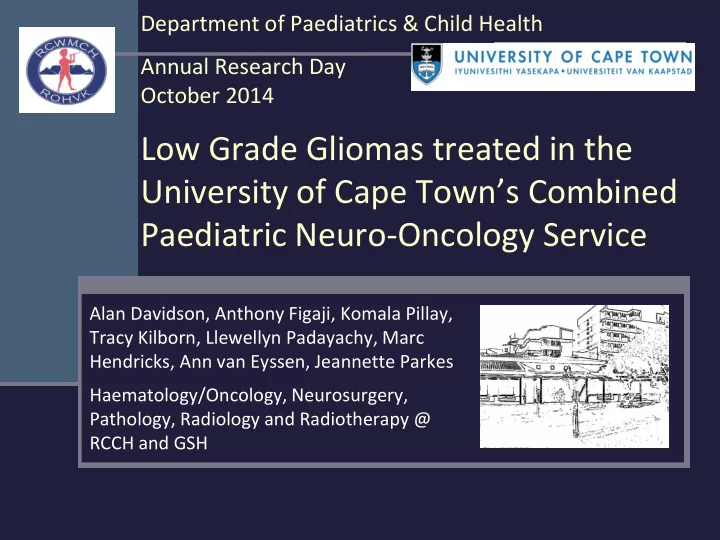

Department of Paediatrics & Child Health Annual Research Day October 2014 Low Grade Gliomas treated in the University of Cape Town’s Combined Paediatric Neuro-Oncology Service Alan Davidson, Anthony Figaji, Komala Pillay, Tracy Kilborn, Llewellyn Padayachy, Marc Hendricks, Ann van Eyssen, Jeannette Parkes Haematology/Oncology, Neurosurgery, Pathology, Radiology and Radiotherapy @ RCCH and GSH
PAEDIATRIC NEURO-ONCOLOGY AT UCT Real time decision-making is achieved via a weekly neuroimaging meeting and regular folder rounds, and long term follow up and surveillance is provided by a combined clinic which attended by paediatric endocrinologists, an educational psychologist and an occupational therapist. Despite involvement by paediatric oncology, chemotherapy only came into routine use for incompletely resected or inoperable LGGs at the turn of the century. This study was a retrospective analysis of the epidemiology, management and outcomes of children with low grade gliomas in order to assess the success of multidisciplinary management. Research Day October 2014
PAEDIATRIC BRAIN TUMOURS at RCCH Of the 1516 children diagnosed with malignancy at the Red Cross Children’s Hospital between 2001 and 2013, 246 had brain tumours representing only 16.2%. Research Day October 2014
CLINICAL APPROACH PRIMARY APPROACH Where possible tumours were resected completely at diagnosis. Irresectable tumours were subject to: [1] watchful waiting [2] chemotherapy (<5-8yrs) or [3] radiotherapy Patients with Nf1 were surveilled with regular ophthalmologic review, and the preference was to defer imaging in asymptomatic patients. Where LGGs were identified and treatment was indicated, chemotherapy was given. AT RELAPSE OR PROGRESSION Surgery if possible. Irresectable tumours were assigned to radiotherapy, or second or third line chemotherapy was initiated. Research Day October 2014
RESULTS 60 children were diagnosed with LGGs between 2001 and 2013. There 29 boys and 31 girls. Age ranged from 0.41 to 13.75 years The Median age was 5.38 years. Research Day October 2014
RESULTS: SITE Supratentorial: 36 (60%) – 25 (42%) from midline structures Infratentorial: 24 (40%) – 18 (30%) in the cerebellum Metastatic disease was seen in 4 patients: 1 cerebral lesion, 2 hypothalamic tumours and 1 brainstem LGG. Research Day October 2014
RESULTS: HISTOLOGY The majority were WHO Grade I (46 patients or 77%) . Patients with WHO grade II LGGs tended to be older than those with grade I LGGs (median age 8.59 vs 4.42). Most of those with metastases had WHO grade II tumours. SACCSG September 2014
RESULTS: Neurocutaneous Syndromes TUBEROUS SCLEROSIS Sub-ependymal Giant Cell Astrocytomas – 2 NEUROFIBROMATOSIS Type 1: Juvenile Pilocytic Astrocytomas – 2 (1) tectum (2) cerebrum Optic Gliomas – 4 Research Day October 2014
TREATMENT: AT DIAGNOSIS SURGERY SURGERY – 13 debulked / 19 resected (17 cerebellar tumours) BIOPSY ONLY – 22 patients NO SURGERY - 6 patients (all optic gliomas) OTHER MODALITIES RADIOTHERAPY – 5 patients CHEMOTHERAPY – 9 patients EXPECTANT MANAGEMENT – 14 (including 5/6 Nf1 patients) Research Day October 2014
TREATMENT NEUROCUTANEOUS SYNDROME PATIENTS Tuberous Sclerosis: One SEGA was totally resected; the other was operated twice but died as a result of a VPS infection. Neurofibromatosis Type 1: The patient with a tectal lesion had debulking surgery at diagnosis, and then required surgery at progression. The others were treated conservatively, and are all alive and progression free. RADIOTHERAPY Fifteen patients came to radiotherapy (25%). 1st line therapy 5; 2nd line therapy 4; 3rd line therapy 6. Research Day October 2014
TREATMENT: CHEMOTHERAPY Thirteen patients in all were treated with chemotherapy. Age Range: 0.41 – 8.25 years. Median Age: 2.67 years. Indications: Irresectable tumours 12; Tectal recurrence 1 Sites: Hypothalamus 8 / Optic Tract 3 / Tectum 1 / Cerebrum 1 Histology: Juvenile Pilocytic Astrocytoma 10 Pilomyxoid Astrocytoma 3 Regimens: 1st line - Vincristine/Carboplatin(VC) 1 ; Temozolomide 1; Vincristine/Etoposide/Carboplatin(VEC) 1 2nd line – VC 3; Vinblastine(Vb) 3; VbC 1 3rd line – Bevacizumab/Irinotecan(BI) 2; Vb 1 Research Day October 2014
OVERALL OUTCOMES Alive and Disease Free 22 Stable Disease off Treatment 26 Stable Disease on Treatment 5 Recurrent Disease – awaiting reoperation 1 Died of disease 3 (2 from shunt complications) Lost presumed dead 2 Lost 1 Research Day October 2014
Research Day October 2014
Research Day October 2014
Low Grade Glioma 2001-2013 5-year Overall Survival by Histology OUTCOMES Log Rank p value = 0.05 Complete Censored 1.0 Cumulative Proportion Surviving 0.9 0.8 OS was better for WHO 0.7 grade I tumours (92.3%) Grade 1 [n=46] 0.6 than for WHO grade II Grade 2 [n=14] 0.5 tumours (74.2%) with a 0.4 p value of 0.05. 0 20 40 60 80 100 120 140 160 180 Time - months There was no difference in PFS, nor any difference by Site. Five of 18 cerebellar tumours recurred but all were salvaged with reoperation, and two went on to receive radiotherapy with an OS for the whole group of 100%. Only 2/15 patients (13%) progressed after radiotherapy. Research Day October 2014
CHEMOTHERAPY OUTCOMES Of the thirteen patients treated with chemotherapy: 1 progressed 3 showed stable disease 9 responded reducing in volume by 40 and 93% (Median of 68%). Estimated OS at 5 years was 100%, but PFS was only 33%. All patients were exposed to carboplatin; 5/13 or 39% developed sustained hypomagnesaemia. Research Day October 2014
CONCLUSIONS Metastases occur more often in WHO II grade tumours. Surgery was successful in controlling Cerebellar tumours. Radiotherapy was only required for 25%, but produced excellent results. Chemotherapy provides excellent control in young patients with irresectable tumours. Overall Survival was better for WHO grade I tumours. Multidisciplinary team management is a viable and effective strategy for the management of low grade gliomas in low and middle income settings. Research Day October 2014
ACKNOWLEDGEMENTS The entire multidisciplinary team: Steve Delport, Ariane Spitaels and Michelle Carrihill Jackie Bean Christine du Toit Michelle Meiring and Di Burger The NHLS Pathology Laboratory staff at RCCH All our patients and their families … Research Day October 2014
Recommend
More recommend